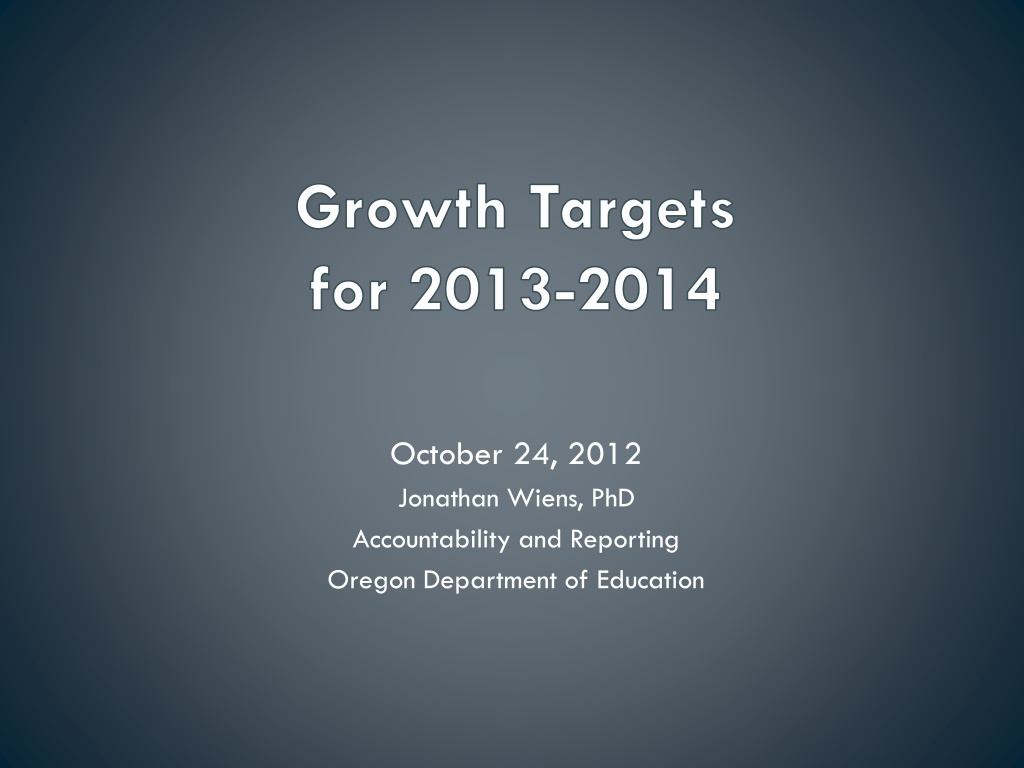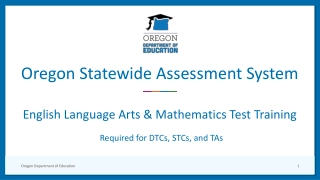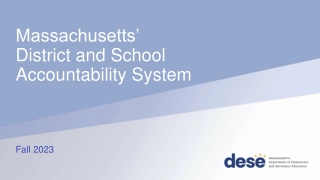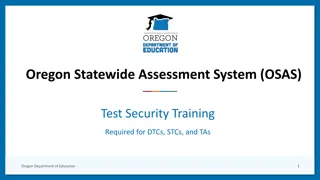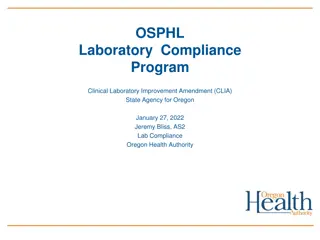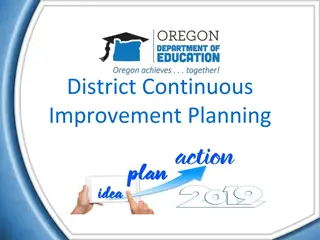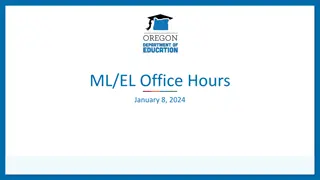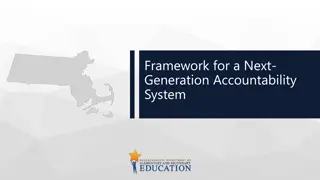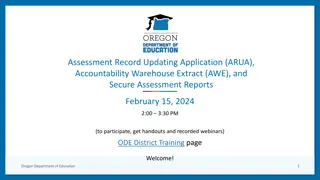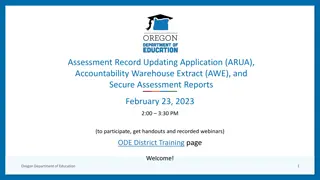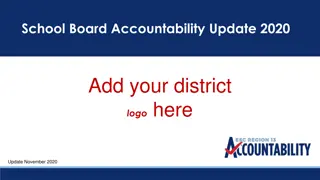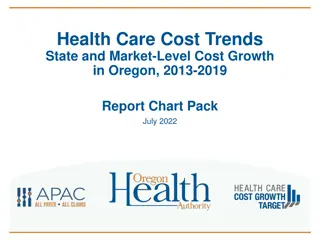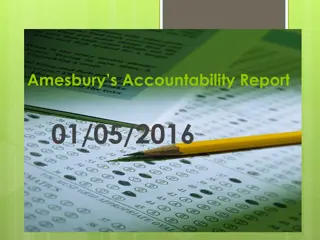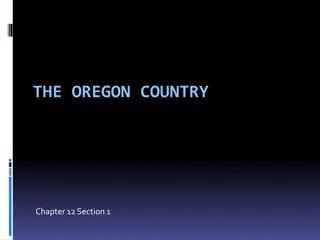Understanding Oregon's Growth Model for Education Accountability
Oregon's Growth Model for education accountability uses a system that compares student growth to academic peers in the state. School growth ratings are determined based on levels of growth in reading and math, with a focus on tracking student progress over time. By comparing growth percentiles and setting growth targets, the model provides a comprehensive approach to measuring educational progress.
Download Presentation

Please find below an Image/Link to download the presentation.
The content on the website is provided AS IS for your information and personal use only. It may not be sold, licensed, or shared on other websites without obtaining consent from the author. Download presentation by click this link. If you encounter any issues during the download, it is possible that the publisher has removed the file from their server.
E N D
Presentation Transcript
Growth Targets for 2013-2014 October 24, 2012 Jonathan Wiens, PhD Accountability and Reporting Oregon Department of Education
Growth Model Overview
Oregons Growth Model Uses the Colorado Growth Model. Includes all students having two consecutive years of standard OAKS assessments, regardless of whether or not they are meeting standard. A student s growth is compared to the growth of other students in the state having the same prior test scores ( Academic Peers ) Student Growth is expressed as a percentile. A growth percentile of 75 would mean the students growth was as high or higher than 75 percent of his/her academic peers. Computes Growth Targets growth percentiles that put a student on track to be at standard in three years. 3
Growth Model Points to Remember Growth is based on comparing a student to his or her Academic Peers, who are students with the similar test score histories. Growth of low performing students is compared to that of other low performing students in the state. Growth of high performing students is compared to that of other high performing students in the state. Growth model applies to students in grades 4 to 8, and 11. Uses up to four years of test data for each student.* * - High school students use only the 7th, 8th and 11th grade scores to evaluate growth. 4
Growth and School Accountability Schools are given Levels in reading and math growth: Level 5: Schools with high growth Level 4: Average to above average growth Level 3: Below average, but not low, growth Level 2: Low growth Level 1: Very low growth Reading and math growth are combined into a Growth Rating. 5
School Growth Ratings School accountability uses the median growth percentile. Median growth is the middle growth percentile. This is the typical growth at the school. We also report the median target growth percentile. A school has On Track growth if the median growth percentile is as high as the median target percentile. On Track growth indicates that a typical student is meeting his/her growth target. Requirements to reach Level 5, Level 4, etc., are lower for schools with On Track growth. 6
Growth Example - Elementary Here is an example of how growth is reported on the School Ratings detail reports. Subgroup growth is also reported. 7
Growth Percentiles in Oregon Growth Percentiles - Reading Grade 6 for 2009-10 25 20 15 Gain in 6th Grade 10 5 0 191 196 201 206 211 216 221 226 231 236 241 246 251 256 261 -5 -10 -15 5th Grade Reading Scores pct10 pct25 pct50 pct75 pct90 8
Sample Growth Percentiles This sample shows various growth percentiles. Note that the middle four students all had the same starting point in 5th grade. The students in red are shown to emphasize that growth is evaluated relative to academic peers, not on absolute gains in test scores. Growth Percentile Growth Target Grade 5 Grade 6 Gain 195 200 5 16 80 209 208 -1 8 72 209 214 5 34 64 209 218 9 61 58 209 226 17 96 48 227 232 5 57 27 9
SGPs Higher Order Growth This data show how 3 years of test scores can affect growth percentiles. Data are taken from Math growth in 2011-12. Affect of using 3 Years of data Growth Percentile Student Grade 3 Grade 4 Grade 5 A -- 211 215 34 -- B 190 211 215 66 +32 C 195 211 215 55 +21 D 200 211 215 42 +8 E 206 211 215 27 -7 F 212 211 215 17 -17 G 218 211 215 8 -26 10
Growth Targets for School Accountability
Growth Targets Growth targets are forward looking. They estimate the growth necessary to meet standard in three more years, or by grade 11. Targets are provided both as percentiles and as RIT scores. The target RIT score represents the typical score attained by students who grew to standard in the past. The target percentile should be viewed as an estimate of the difficulty of attaining the goal of proficiency in three years. Target Grade Grade 3 6 4 7 5 8 6 11 7 11 8 11 12
Target Growth This data show how using three years of test scores affect growth percentiles and create a more complete view of growth. Data are taken from 5th grade Math growth in 2011-12. 6th Grade Target RIT Growth Percentile Target Percentile Student Grade 3 Grade 4 Grade 5 B 190 211 215 66 69 220 C 195 211 215 55 68 221 D 200 211 215 42 66 221 E 206 211 215 27 64 222 F 212 211 215 17 63 222 G 218 211 215 8 62 223 13
Growth Targets, continued The data below shows how important it is to remember that the growth data is based on academic peers, who are students with similar score histories. Targets for Students with Same Prior Test Score 8th Grade Growth Targets 7th Grade Growth Percentile Math Score Histories Student 4th 5th 6th 7th Percentile RIT A 205 212 213 225 66 73 229 B 225 228 222 225 4 59 233 14
2012-13 State Level Data
Reading Growth by Subgroup Growth does vary by subgroup, but by far less than status varies. The differences below amount to only one or two RITs points. Median Reading Growth Percentile By Subgroup Asian 55 White 51 All Students 50 Multi-Racial 50 Ever English Learner 48 Native Hawaiian/Pacific Islander 45 Underserved Race/Ethnicity 47 Economically Disadvantaged 47 Hispanic/Latino 47 English Learner 47 American Indian/Alaska Native 46 Black/African American 45 Students with Disabilities 44 16 0 10 20 30 40 50 60 70
Mathematics Growth by Subgroup Growth does vary by subgroup, but by far less than status varies. The differences below amount to only one or two RITs points. Median Mathematics Growth Percentile By Subgroup Asian 60 White 51 All Students 50 Multi-Racial 50 Ever English Learner 49 Native Hawaiian/Pacific Islander 49 Underserved Race/Ethnicity 47 Economically Disadvantaged 47 Hispanic/Latino 47 English Learner 46 American Indian/Alaska Native 44 Black/African American 44 Students with Disabilities 42 17 0 10 20 30 40 50 60 70
Interpreting Growth at the Student Level
Typical Growth While growth targets are used for school accountability, it is important to remember that growth for individual students should be a much more nuanced conversation. To help teachers and parents interpret growth, we classify growth in one of three categories: Low Growth: growth below the 35th percentile. Typical Growth: growth between the 35th and 65th percentile. High Growth: growth above the 65th percentile. At this point we have not had the chance to produce individual student growth reports, but if we did 19
Student Growth Report (forthcoming) This is a sample that would show (in graphic format) the data you have access to today. Typical Growth: growth between the 35th and 65th percentile. High Growth: growth above the 65th percentile. At this point we have not had the chance to produce individual student growth reports, but if we did 20
Growth Goals A thorough discussion of individual growth goals should take into account: The growth target (i.e., target for proficiency in three years) The Low, Typical, and High growth ranges. Remember that student growth occurs in a range and that, by definition: about one third of students are likely to show low growth; about one third of students are likely to show typical growth; and about one third of students are likely to show high growth. For students well above standard the target represents fairly low growth. For students well below standard the target represents high growth. 21
Growth Goals, continued Even though average growth does differ slightly by subgroup, the ranges for low, typical, and high growth are still reasonable, regardless of subgroup. However, the fact that the English Learner (EL) and Students with Disabilities (SWD) subgroups have lower growth shows that the Oregon Growth Model is not a true value-added model. Teachers with high percentages of EL or SWD students might want to take this into account when setting growth goals using this growth model. 22
Review of Data File Includes all students enrolled in grades 3 to 8 on May 1, 2013. Includes resident school and district from May 1. Includes resident and attending school and district from SSID (as of October 23). Extended assessment are not included. Students taking extended assessments will not have any growth or target data. A simplified table of growth targets is also available at: http://www.ode.state.or.us/search/page/?id=3797 23
How to get your data Contact your ESD Partners: http://www.ode.state.or.us/wma/teachlearn/testing/o aks/esdpartners1314.pdf Individual school requests are discouraged, it creates a huge workload issue. Instead, District Test Coordinators should contact the ESD Partners to request data. DTCs can then send the data to internal district staff. Remember: these files contain FERPA protected data! 24
Contact Information and Links Main report card page: http://www.ode.state.or.us/search/page/?id=1786 Details on priority, focus, and model schools: http://www.ode.state.or.us/search/page/?id=3742 Report Cards and Report Card ratings details: http://www.ode.state.or.us/data/reportcard/reports.aspx Repot Card resources: http://www.ode.state.or.us/search/page/?id=3881 Contacts: Jon Wiens: email: jon.wiens@state.or.us phone: 503-947-5764 Josh Rew: email josh.rew@state.or.us phone: 503-947-5845 25
